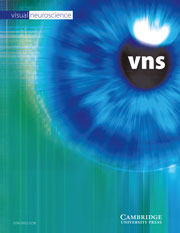Article contents
Temporal properties of surround suppression in cat primary visual cortex
Published online by Cambridge University Press: 09 August 2007
Abstract
The responses of neurons in primary visual cortex (V1) are suppressed by stimuli presented in the region surrounding the receptive field. There is debate as to whether this surround suppression is due to intracortical inhibition, is inherited from lateral geniculate nucleus (LGN), or is due to a combination of these factors. The mechanisms involved in surround suppression may differ from those involved in suppression within the receptive field, which is called cross-orientation suppression. To compare surround suppression to cross-orientation suppression, and to help elucidate its underlying mechanisms, we studied its temporal properties in anesthetized and paralyzed cats. We first measured the temporal resolution of suppression. While cat LGN neurons respond vigorously to drift rates up to 30 Hz, most cat V1 neurons stop responding above 10–15 Hz. If suppression originated in cortical responses, therefore, it should disappear above such drift rates. In a majority of cells, surround suppression decreased substantially when surround drift rate was above ∼15 Hz, but some neurons demonstrated suppression with surround drift rates as high as 21 Hz. We then measured the susceptibility of suppression to contrast adaptation. Contrast adaptation reduces responses of cortical neurons much more than those of LGN neurons. If suppression originated in cortical responses, therefore, it should be reduced by adaptation. Consistent with this hypothesis, we found that prolonged exposure to the surround stimulus decreased the strength of surround suppression. The results of both experiments differ markedly from those previously obtained in a study of cross-orientation suppression, whose temporal properties were found to resemble those of LGN neurons. Our results provide further evidence that these two forms of suppression are due to different mechanisms. Surround suppression can be explained by a mixture of thalamic and cortical influences. It could also arise entirely from intracortical inhibition, but only if inhibitory neurons respond to somewhat higher drift rates than most cortical cells.
Information
- Type
- Research Article
- Information
- Copyright
- © 2007 Cambridge University Press
References
REFERENCES
- 29
- Cited by

